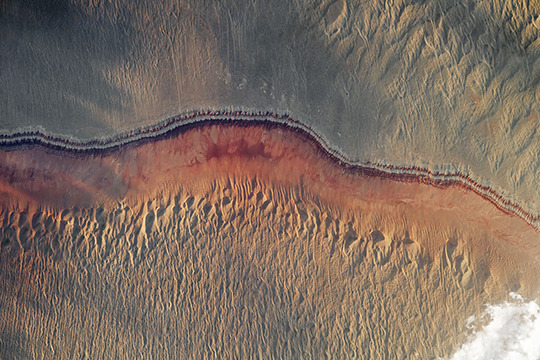#PlanetaryScience
Explore tagged Tumblr posts
Text

Two hours before its closest approach to Neptune in 1989, Voyager 2 captured this haunting glimpse of the distant blue world—our first real look at the planet’s ethereal beauty, suspended in the void, silent and untouchable.
#nasa#astronomy#astrophotography#universe#cosmos#milkyway#nebula#stars#galaxy#spacex#photography#solarsystem#stargazing#telescope#blackhole#voyager2#neptune#spaceart#planetaryscience#art#aesthetic#portrait#landscape#nature
134 notes
·
View notes
Text
Junggar Basin Aglow

The low sun angle in this astronaut photo of Junggar Basin shows off the wind- and water-carved landscape. Located in northwestern China, this region is covered in dune fields, appearing along the top and bottom of the image. (Image credit: NASA; via NASA Earth Observatory) Read the full article
39 notes
·
View notes
Photo

Earth’s rotation time increases by 000.1 seconds every year. #FACT
#the fact site#science#science stuff#science facts#fun facts#earth#earth facts#physics#physics facts#planetaryscience#geophysics
11 notes
·
View notes
Video
youtube
Alien Life? A Distant Planet's Secret! #sciencefather #science #scientist
Astronomers have recently detected what might be a potential sign of life 🌱 on a distant exoplanet 🌍 orbiting a star far beyond our solar system. Using advanced telescopes 🔭, scientists observed unusual chemical signatures—specifically dimethyl sulfide (DMS)—a gas that, on Earth, is only produced by living organisms 🧬. While this discovery doesn’t confirm alien life 👽 just yet, it adds an exciting piece to the cosmic puzzle 🧩. Researchers are urging caution 🚨, reminding everyone that further investigation is needed to rule out non-biological sources. Still, this breakthrough fuels the hope that we might not be alone in the universe 🌌✨.
Natural Scientist Awards
Nomination Link: https://naturalscientist.org/award-nomination/? ecategory=Awards&rcategory=Awardee
Visit Our Website 🌐naturalscientist.org
Contact us [email protected]
Get Connected Here:
LinkedIn: https://www.linkedin.com/in/natural-scientist-466a56357/
Blogger: https://naturalaward.blogspot.com/
Instagram: https://www.instagram.com/natural_scientist/
Pinterest: https://in.pinterest.com/research2805/_profile/
Youtube: https://www.youtube.com/@NaturalScientistAwards
Facebook: https://www.facebook.com/profile.php?id=61574191899176
#youtube#sciencefather#naturalscientistawards#researchawards#space#nasa#exoplanets#astronomy#science#alienlife#universe#astrobiology#spacediscovery#distantlands#lifeinspace#spaceexploration#cosmos#spacenews#astronomers#physicists#spaceexplorers#planetaryscience#exoplanetresearch#scientificdiscovery#researchers#institute#telescope#investigations#scientists#cosmicresearch
3 notes
·
View notes
Text
One year on this giant, blistering hot planet is just 16 hours long
🧬 ..::Science & Tech::.. 🧬 A newly discovered “ultrahot Jupiter” has the shortest orbit of any known gas giant
#MIT#KavliInstitute#Exoplanets#NASA#PlanetaryScience#Research#Satellites#SchoolOfScience#Space#Stars#Astronomy#Astrophysics
2 notes
·
View notes
Text
youtube
Europa Clipper is a NASA mission designed to explore Europa, one of Jupiter's largest moons. Scheduled for launch in the 2020s, Europa Clipper will conduct detailed reconnaissance of Europa’s ice-covered ocean, which may harbor conditions suitable for life. The spacecraft is equipped with a suite of scientific instruments to study Europa's surface, subsurface ocean, and geologic activity.
#europaclipper#nasa#Jupiter#europa#spaceexploration#MissionToEuropa#searchforlife#outersolarsystem#nasaexploration#IcyMoons#EuropaMission#spacescience#astrobiology#jupitermoon#nasaupdates#spacetechnology#EuropaOcean#spaceresearch#planetaryscience#EuropaFlyby#NASA2020s#aircraftconstruction#aviationsustainability#aerospacetechnology#EuropaClipperMission#jupiterexploration#EuropaMoon#spacediscovery#LifeOnEuropa#nasaresearch
2 notes
·
View notes
Text
The role of lunar exploration in understanding Earth's history

Lunar exploration has long captured the imagination of scientists and space enthusiasts alike. But beyond the excitement of moon landings and potential colonies, exploring the moon plays a crucial role in helping us understand Earth's history. Here's how:
The Moon as a time capsule
The moon acts as a natural time capsule. Unlike Earth, which undergoes constant change due to weather, tectonic activities, and human influence, the moon's surface remains relatively undisturbed. This preservation allows scientists to study its surface and gain insights into the early solar system, including the formative years of our own planet.
Understanding Earth's early days
By examining lunar rocks and soil, scientists can learn about the conditions that prevailed in the early solar system. The similarities and differences between lunar and terrestrial samples can help us piece together the history of planetary formation. For instance, the analysis of moon rocks brought back by the Apollo missions revealed that both the Earth and the moon share a common origin, likely from a colossal impact event.
Impact history
The moon’s surface is dotted with craters, a record of countless impacts over billions of years. By studying these craters, scientists can understand the history of asteroid and comet impacts in our solar system. This information is crucial because the same impacts that shaped the moon have also affected Earth. Learning about these events helps us understand the frequency and scale of impacts that have influenced Earth’s geological and biological history.
Lunar geology and Earth's evolution
Moon exploration has uncovered much about the moon’s geology, which in turn informs our understanding of Earth's geological processes. The moon’s lack of atmosphere means that its surface has remained largely unchanged, preserving a pristine record of its geological history. By comparing this with Earth's dynamic geology, scientists can infer the processes that have shaped our planet over time.
The Moon as a mirror
The moon also serves as a mirror to study Earth. Observations of Earth from the lunar surface provide unique perspectives that are impossible to obtain from Earth itself. These observations help scientists understand Earth's atmosphere, weather patterns, and environmental changes from a different vantage point.
Preparing for the future
Lunar exploration is not just about looking back; it’s also about preparing for the future. By studying the moon, scientists and engineers are developing technologies and strategies that will be essential for future space exploration. This includes learning how to build sustainable habitats, utilize lunar resources, and protect astronauts from space radiation. These advancements will be crucial for future missions to Mars and beyond.
Lunar exploration offers a window into the past, providing valuable insights into Earth's history and the broader solar system. By continuing to explore and study the moon, we not only unravel the mysteries of our own planet’s origins but also pave the way for humanity’s future in space. The moon holds the keys to many questions about our past, present, and future, making its exploration a vital endeavor for scientific discovery and advancement.
#lunar#lunarhistory#earthhistory#moonexploration#spaceexploration#scientificdiscovery#nasa#astronomy#solarsystem#space#cosmichistory#geology#apollo#futuremissions#scienceinnovation#planetaryscience
3 notes
·
View notes
Text
Earth’s Temporary Second Moon: A Cosmic Visitor in Our Orbit.
#SecondMoon#MiniMoon#Asteroid2020CD3#CosmicVisitor#SpaceExploration#Astronomy#EarthOrbit#NearEarthObjects#PlanetaryScience#TemporarySatellite#SpaceFacts
2 notes
·
View notes
Text
🌌 AI in Space Exploration: Transforming Satellite Data and Planetary Science
AI in space exploration is revolutionizing satellite data and planetary science. Discover how artificial intelligence powers modern space missions and data analysis. The integration of AI in space exploration has revolutionized how scientists analyze satellite data and understand distant planetary environments. With increasing volumes of cosmic data, artificial intelligence is enabling faster…
0 notes
Text
“Extraordinary claims require extraordinary evidence.”

Carl Edward Sagan was an American astronomer, planetary scientist, and science communicator. His best-known scientific contribution is his research on the possibility of extraterrestrial life, including the experimental demonstration of the production of amino acids from basic chemicals by exposure to light.
Born: 9 November 1934, Brooklyn, New York, United States
Died: 20 December 1996 (age 62 years), Fred Hutch Cancer Center, Seattle, Washington, United States.
Popularised Science Through “Cosmos” Sagan co-wrote and hosted Cosmos: A Personal Voyage (1980), a groundbreaking TV series that brought astronomy and the wonder of the universe into millions of homes. It became one of the most-watched PBS series in history.
Worked on NASA Missions He played a major role in several NASA missions, including the Mariner, Viking, Voyager, and Galileo programs. He helped design messages for extraterrestrial life, like the Golden Record aboard Voyager.
Pioneer of Planetary Science Sagan was instrumental in explaining the greenhouse effect on Venus, the seasonal changes on Mars, and the nature of Saturn's moon Titan. He essentially helped define planetary science as a field.
Wrote the Novel Contact His 1985 science-fiction novel Contact (later made into a film starring Jodie Foster in 1997) tackled the philosophical and scientific implications of contact with extraterrestrial life.
Advocated Against Nuclear Weapons Sagan warned about “nuclear winter”—the potential climate effects of widespread nuclear war. He used his platform to push for nuclear disarmament during the Cold War, blending science with social responsibility.
#CarlSagan#Cosmos#ScienceCommunicator#PaleBlueDot#Astrophysics#AstronomyLegend#PlanetaryScience#NASAContributor#GoldenRecord#VoyagerMissions#CosmicPerspective#Humanist#Skepticism#NuclearDisarmament#ScientificWonder#ContactTheNovel#StarStuff#SecularHumanism#EducatorExtraordinaire#VoiceOfTheCosmos#quoteoftheday#new blog#today on tumblr
0 notes
Text
Sights on a new flyby for New Horizons – Astronomy Now

In 2019, NASA’s New Horizons spacecraft flew past Arrokoth, the most distant and primitive object ever explored. Now, as it ventures further, chief scientist Alan Stern shared exciting updates. New Horizon targeted Arrokoth in a close flyby in 2019. Read more
#NewHorizons#AstronomyNews#SpaceExploration#AstronomyNow#NASA#SpaceScience#FlybyMission#SolarSystemExploration#Astrophysics#SpaceDiscovery#AstronomyUpdates#SpaceResearch#NASAUpdates#PlanetaryScience#NewHorizonsMission#SpaceNews#StellarExploration#SpaceTech#AstronomyLovers
1 note
·
View note
Text
youtube
#MassExtinction#SupernovaExplosion#CosmicDisaster#Astrophysics#SpaceScience#ExtinctionEvents#EarthHistory#OzoneDepletion#StellarDeath#DevonianExtinction#OrdovicianExtinction#CosmicRadiation#PlanetaryScience#CelestialEvents#SupernovaImpact#Astrobiology#ExoplanetScience#SpaceCatastrophe#CosmicForces#EvolutionaryHistory#ScientificDiscovery#SpacePhenomena#RadiationExposure#AncientExtinctions#EarthScience#SpaceAndTime#InterstellarExplosions#ExtremeAstrophysics#GalacticEvents#UVRadiation
0 notes
Link
#aerosols#atmosphericscience#duststorm#fluiddynamics#meteorology#physics#planetaryscience#plumes#science
22 notes
·
View notes
Photo

Venus, Saturn, Uranus, and Neptune all have surface gravities relatively close to Earth’s, differing by less than 15%. #FACT
#the fact site#space#space facts#solar system#fun facts#physics#physics facts#interesting facts#gravity#planetaryscience#planetarygravity
4 notes
·
View notes
Video
youtube
Strawberry Moon: June's Celestial Wonder! #sciencefather #researchawards #scientist #fullmoon
🌕 June 2025 Full Moon: It’s been years since we’ve seen a full moon quite like this! The night sky lit up with an ethereal glow as the Strawberry Moon rose in all its brilliance 🌌✨. With its soft amber hue and low horizon position, the moon appeared larger and more golden than usual—an awe-inspiring sight for skywatchers and photographers alike 📷🌙. This breathtaking lunar moment, untouched by city lights or cloud cover, reminded many of timeless nights spent stargazing under open skies 🌠🌾. Whether you watched from a mountaintop, a quiet backyard, or through a telescope, this full moon was a celestial treat worth remembering 🌍🔭💫.
Natural Scientist Awards
Nomination Link: https://naturalscientist.org/award-nomination/?ecategory=Awards&rcategory=Awardee
Visit Our Website 🌐naturalscientist.org
Contact us [email protected]
Get Connected Here:
LinkedIn: https://www.linkedin.com/in/natural-scientist-466a56357/
Blogger: https://naturalaward.blogspot.com/
Instagram: https://www.instagram.com/natural_scientist/
Pinterest: https://in.pinterest.com/research2805/_profile/
Youtube: https://www.youtube.com/@NaturalScientistAwards
Facebook: https://www.facebook.com/profile.php?id=61574191899176
#youtube#sciencefather#naturalscientistawards#researchawards#moonwatching#nightsky#celestialevent#moonphotography#supermoon#skygazing#astronomyevents#fullmoon#moonlovers#nightphotography#astronomyresearch#lunar#moonobservation#astrophysics#spaceweather#celestialmechanics#planetaryscience#moonresearch#astronomers#spaceexploration#observational#mooncycle
0 notes
Link
The Beginning of the Soviet Conquest of VenusIn the 1960s, the Soviet Union launched an ambitious series of missions to explore Venus, a planet shroud...
#Veneraprobes#Sovietspacemissions#Venusexploration#Venera13#Venera14#Spaceexploration#Planetaryscience#Venuslanders
0 notes